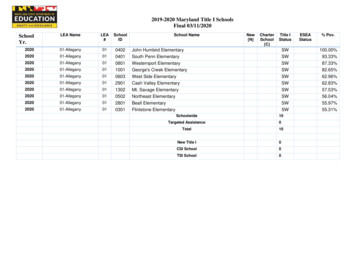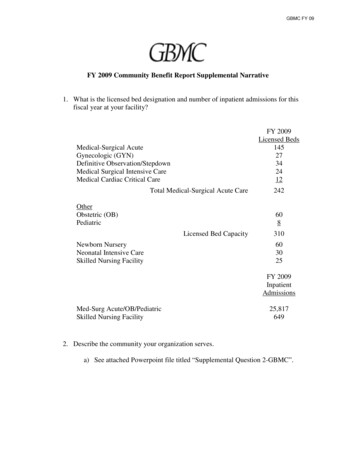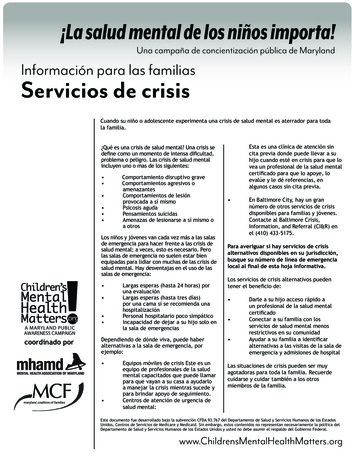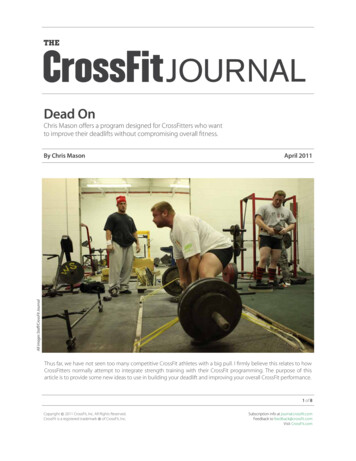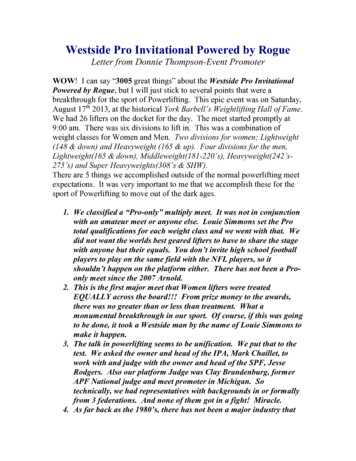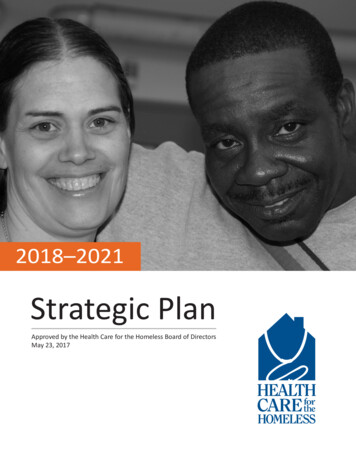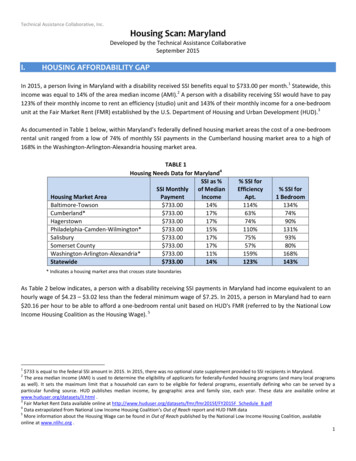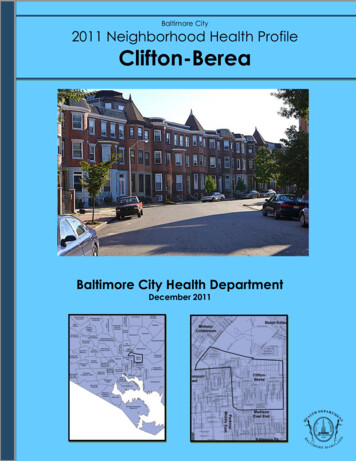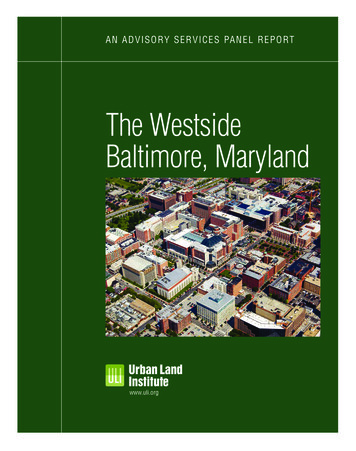
Transcription
AN AD V IS O RY S E R V IC E S PA N E L R EPORTThe WestsideBaltimore, Marylandwww.uli.orgCover Baltimore.indd 34/22/11 9:53 AM
The WestsideBaltimore, MarylandA Vision for the Westside NeighborhoodDecember 5–10, 2010An Advisory Services Program ReportUrban Land Institute1025 Thomas Jefferson Street, NWSuite 500 WestWashington, DC 20007-5201
About the Urban Land InstituteT he mission of the Urban Land Institute is toprovide leadership in the responsible use ofland and in creating and sustaining thrivingcommunities worldwide. ULI is committed toBringing together leaders from across the fieldsof real estate and land use policy to exchange bestpractices and serve community needs;Fostering collaboration within and beyond ULI’smembership through mentoring, dialogue, andproblem solving;Exploring issues of urbanization, conservation,regeneration, land use, capital formation, andsustainable development;Advancing land use policies and design practicesthat respect the uniqueness of both built and naturalenvironments; Sharing knowledge through education, appliedresearch, publishing, and electronic media; andSustaining a diverse global network of local practiceand advisory efforts that address current and futurechallenges.Established in 1936, the Institute today has nearly30,000 members worldwide, representing theentire spectrum of the land use and developmentdisciplines. ULI relies heavily on the experience ofits members. It is through member involvement andinformation resources that ULI has been able to setstandards of excellence in development practice.The Institute has long been recognized as one of theworld’s most respected and widely quoted sources ofobjective information on urban planning, growth,and development.Cover photo 2010 J. Brough Schamp/www.schamp.com 2011 by the Urban Land Institute1025 Thomas Jefferson Street, NWSuite 500 WestWashington, DC 20007-5201All rights reserved. Reproduction or use of the whole orany part of the contents without written permission of thecopyright holder is prohibited.2An Advisory Services Panel Report
About ULI Advisory ServicesThe goal of ULI’s Advisory Services Program isto bring the finest expertise in the real estatefield to bear on complex land use planning anddevelopment projects, programs, and policies.Since 1947, this program has assembled well over 400ULI–member teams to help sponsors find creative,practical solutions for issues such as downtownredevelopment, land management strategies,evaluation of development potential, growthmanagement, community revitalization, brownfieldsredevelopment, military base reuse, provision of lowcost and affordable housing, and asset managementstrategies, among other matters. A wide variety ofpublic, private, and nonprofit organizations havecontracted for ULI’s Advisory Services.Each panel team is composed of highly qualifiedprofessionals who volunteer their time to ULI.They are chosen for their knowledge of the paneltopic and screened to ensure their objectivity. ULI’sinterdisciplinary panel teams provide a holistic look atdevelopment problems. A respected ULI member whohas previous panel experience chairs each panel.The agenda for a five-day panel assignment isintensive. It includes an in-depth briefing daycomposed of a tour of the site and meetings withsponsor representatives; a day of hour-long interviewsof typically 50 to 75 key community representatives;and two days of formulating recommendations. Longnights of discussion precede the panel’s conclusions.On the final day on site, the panel makes an oralpresentation of its findings and conclusions to thesponsor. A written report is prepared and published.Because the sponsoring entities are responsiblefor significant preparation before the panel’s visit,including sending extensive briefing materials to eachmember and arranging for the panel to meet withkey local community members and stakeholders inthe project under consideration, participants in ULI’sfive-day panel assignments are able to make accurateassessments of a sponsor’s issues and to providerecommendations in a compressed amount of time.Baltimore, Maryland, December 5–10, 2010A major strength of the program is ULI’s uniqueability to draw on the knowledge and expertise of itsmembers, including land developers and owners,public officials, academics, representatives of financialinstitutions, and others. In fulfillment of the missionof the Urban Land Institute, this Advisory Servicespanel report is intended to provide objective advicethat will promote the responsible use of land toenhance the environment.ULI Program StaffGayle BerensSenior Vice President, Education and Advisory GroupThomas W. EitlerVice President, Advisory ServicesPatrick PontiusDirector, Education and Advisory GroupTheodore C. ThoerigManager, Education and Advisory GroupCaroline DietrichPanel Associate, Education and Advisory GroupGwen McCallSenior Administrative Manager, Education andAdvisory GroupJames A. MulliganManaging EditorLaura Glassman, Publications Professionals LLCManuscript EditorBetsy VanBuskirkCreative DirectorDeanna Pineda, Muse Advertising DesignLayout ArtistCraig ChapmanSenior Director, Publishing Operations3
AcknowledgmentsThe panel wishes to thank Mayor StephanieRawlings-Blake for her commitment torevitalizing the Westside. The panel wouldalso like to thank Kaliope Parthemos, deputymayor for economic and neighborhood development,and her staff for organizing and leading the effort ofpreparing the briefing book for panelists, organizingthe interview sessions, and hosting the visit.The panel recognizes the efforts and contributions ofthe many individuals and organizations that madethis study possible. In particular the panel would4like to thank the city of Baltimore DevelopmentCorporation; Downtown Partnership of Baltimore,Inc.; Greater Baltimore Committee; University ofMaryland, Baltimore; University of Maryland BioPark;the Harry and Jeanette Weinberg Foundation, Inc.;University of Maryland Medical System; LexingtonMarket; Maryland Department of Planning; WestsideRenaissance, Inc.; France-Merrick Foundation;1st Mariner Arena; the Abell Foundation; and theBaltimore City Department of Planning for theirsponsorship and participation.An Advisory Services Panel Report
ContentsULI Panel and Project Staff6The Study Area and the Panel’s Assignment7Market Potential11Vision and Development Strategy19Planning and ut the Panel32Baltimore, Maryland, December 5–10, 20105
ULI Panel and Project StaffPanel ChairGlenda E. HoodFormer Mayor of OrlandoFormer Secretary of State of FloridaOrlando, FloridaPanel MembersAbigail FerrettiPrincipalPartners for Economic SolutionsWashington, D.C.Owen LangConsultantOwen Lang ConsultingPetaluma, CaliforniaStanley LoweManaging PartnerFourth River Development, LLCPittsburgh, PennsylvaniaBetty MasseyExecutive DirectorMary Moody Northen EndowmentGalveston, Texas6Ehud MouchlyOwnerREADI, LLCLos Angeles, CaliforniaTom MurphySenior Resident Fellow, ULI/Klingbeil Family Chairfor Urban DevelopmentUrban Land InstituteWashington, D.C.Ranne WarnerDeveloperZeckendorf DevelopmentNew York, New YorkULI Project StaffPatrick PontiusDirector, Education and Advisory GroupTheodore C. ThoerigManager, Education and Advisory GroupCaroline DietrichAssociate, Education and Advisory GroupAn Advisory Services Panel Report
The Study Area and thePanel’s AssignmentBaltimore is one of the United States’ oldest andmost historic cities. The port city, founded in1729, was an important engine of economicgrowth and trade; by the time of the CivilWar, the city was second only to New York Cityin population. Like many other industrial towns,Baltimore suffered from the country’s post–WorldWar II suburbanization and economic shift frommanufacturing to service industries, steadily losingpopulation and significance through the secondhalf of the 20th century. More recently, however,Baltimore has reinvented itself: revitalization effortshave restored the city’s waterfront and historicneighborhoods, and the growth of life sciences, healthservices, and financial sectors has buoyed the localeconomy. The city, with abundant cultural amenities,historic character, and an affordable housing market,now stands primed to attract new residents.stores. Changing retail patterns and middleclass flight to the suburbs led to its steady declinethroughout the second half of the 20th century. Today,the Westside remains seriously challenged by issuesof retail vacancy, public safety, and lack of sustainableprivate investment.The commitment to Baltimore’s Westside revitaliza tion began ten years ago. Over that time, the privateand public sectors have made investments of morethan 800 million. Although the Westside’s reboundhas trailed similar redevelopment areas in the city, thevision and potential to restore the area to its formerglory—albeit in a different form, as a predominantlyresidential mixed-use neighborhood—remains strong.Regional ONTGOMERYLOUDOUNSilver RappBaltimore, Maryland, December 5–10, 2010sqUnfortunately, similar success has not taken hold inthe Westside neighborhood. The Westside was oncethe unquestioned retail center of Baltimore, a regionaldestination anchored by four major more is also a city of neighborhoods. The city’svitality can be measured by the strength of theseenclaves: Fells Point, picturesque seaport byWdayASHINGTONPo Federaland hip dining and entertainment by night;tomacR.Hill, a neighborhood that escaped the boom-andbust cycle and preserves the city’s history and hasattracted young professionals and families with itsactive Main Street and nightlife; Mount Vernon, thecity’s center for culture and arts; and Harbor East, aformer brownfield industrial district transformed intoa new neighborhood of upscale boutiques, residences,and restaurants—to name a few. The resurgence ofBaltimore’s neighborhoods, many of them historic,was led by strong partnerships between the cityand the business community. Baltimore became apioneer in large-scale urban revitalization, creating ablueprint for other cities on how to restore economicvitality through historic preservation.ahannockR.7
Aerial view of downtown Baltimore with the Westsidestudy area highlighted in red. A few major institutionalanchors are identified.Howard StreetCorridorSuperblocket CorridorLexingtonMarketHistoric Charles StreAntiqueRowCenterpointattractions, and historic sites. The Westside is wellserved by transit, with access to the city’s light-railand Metro subway systems, the free Charm CityCirculator, and regular bus service.The Panel’s AssignmentThe city of Baltimore sponsored the ULI AdvisoryServices panel to examine the Westside neighborhood.The panel was asked to determine how the areacan attract new residents and businesses withconsideration for its market potential; historiccharacter; access to transportation; arts, retail,and residential uses; open-space potential; andanchor institutions, as well as to address possibleimplementation strategies. Although the sponsorasked the panel to address many issues, its assignmentcan be distilled into the following questions: The Westside study area is bounded roughly byCharles Street to the east, Pratt and Camden streetsto the south, Martin Luther King, Jr. Boulevardto the west, and Chase Street to the north. Theapproximately 100-square-block neighborhood isconnected to four adjacent and strong submarkets:Mount Vernon and Seton Hill, historic residentialneighborhoods; University Center, the academic,research, and institutional center of the University ofMaryland, Baltimore (UMB), University of MarylandMedical System (UMMS), and University of MarylandBioPark; the central business district (CBD); and asports and entertainment district, with CamdenYards, M&T Bank Stadium, and the convention center.The area is home to major downtown employers,medical and educational institutions, arts and cultural8 What types of uses and density best address thecurrent and future market demands?Where are the best areas to achieve a critical massof activity, and most important, how can thisdevelopment be implemented?What is the future identity of the Westside? Whatdoes the city need to do to create a sense of place?Summary of RecommendationsThe panel spent considerable time reviewingdocuments, being briefed by city and agency staff,and interviewing close to 100 key communitystakeholders. As Baltimore’s native son H. L.Mencken has often been quoted as saying: “For everycomplex and difficult problem, there is an answerthat is simple, easy, and wrong.” With that warningin mind, the panel approached the enormity andcomplexity of the Westside, arriving at the followingrecommendations:An Advisory Services Panel Report
The Westside is anchoredby its two largestemployers, the Universityof Maryland, Baltimore,and the University ofMaryland Medical System. Form the Westside Task Force. The panelrecommends the creation of a task force, cochairedby the mayor and the UMB president, to create astrategic plan to realize the vision for the Westside.The task force will provide direction and engagewith the coordinating redevelopment organizations,such as the Baltimore Development Corporation(BDC) and the Downtown Partnership of Baltimore,Inc. A host of private, nonprofit, and quasigovernmental organizations are also committedto a resurgent Westside and should be either at thetable or closely involved. The Westside Task Forcewill provide two elements that are critical to therevitalization of the neighborhood: Renew authority and urgency. Through thepanel’s briefings and interviews, it learnedthat no single person has been granted theauthority, power, and immediate availability ofresources to lead the Westside revitalization. Thepanel believes that the mayor, in making thisa centerpiece of her vision for the city, shouldappoint an individual to implement the strategicBaltimore, Maryland, December 5–10, 2010plan. Without a clear vesting of authority in oneperson who has the ability to draw on politicalcapital and the strength to pull multiple agenciesand resources into a cohesive team, the Westsidewill remain seriously challenged by the sameissues of vacancy, public safety, and lack ofprivate investment. Forge a critical partnership. The panel believesthat UMB, the largest employment partnerinstitution in the Westside neighborhood, shouldbe fully involved in leading this revitalization.The opening up of the university and itstremendous resources to the neighborhood couldcatalyze residential development and improvepublic safety.Understand the demographics and market demand.Residential, rather than retail development, willlead the Westside renaissance. The market analysissection of this report shows that the Westsideneighborhood could support the development ofmore than 2,000 new residential units in the next9
decade, with immediate potential in housing forgraduate students. The city should also exploreemployer-assisted homeownership programs,because the neighborhood currently lackshomeownership options for the thousands of peoplewho work there. Resolve issues related to historic preservation.The stalled Superblock project has been a drain onthe neighborhood’s redevelopment for too long.The panel recommends that either the projectbe developed by the current developer with theapproval of the Maryland Historical Trust (MHT),or the land disposition agreement be dissolved. Nomore extensions should occur. The city should thenestablish a framework to better understand theoverall costs of rehabilitating the neighborhood’shistoric buildings.1 Address public safety issues. Without addressingthe real and perceived public safety issues on theWestside, particularly around Lexington Market,the neighborhood’s revitalization will not occur.Addressing the public safety issues, throughpartnerships with the university and social serviceagencies and providers, is a first-order priority forthe task force.Develop a network of connectivity. Many ofthe existing assets in the Westside are isolatedand disconnected. The city should focus onstrengthening connections, particularly on eastwest streets, to link the university campus and theCBD. Green streetscape improvements, additionalopen space, and new wayfinding and signage willalso give the neighborhood a distinct identity. Inparticular, the arena site presents an opportunity fora large urban park.1. Since the panel issued its recommendations on December 10, 2010, the following actions have occurred on the Superblock/Memorandumof Agreement: on December 22, 2010, the Baltimore City Board of Estimates approved a six-month extension of the Land Disposition Agreement withdeveloper Lexington Square Partners (LSP). On the same day, the MHT issued a conditional approval of the current LSP plan, which the BDC thenaccepted on December 30, 2010. At the date of publication, the LSP plan is in the city and state approvals processes.10An Advisory Services Panel Report
Market PotentialMany conceptions have surfaced for what theWestside should be—an arts and entertainmentdistrict, for instance, or a restored regionalretail destination replete with urban bigbox stores. This section shows what the neighborhoodcan realistically support in terms of residential, retail,office, and arts and entertainment uses.Overall Economic and DemographicConditionsEconomic conditions in the national and regionalmarketplace are affecting spending and developmentopportunities. The Baltimore region lost 54 percent ofmanufacturing jobs between 1990 and 2009. In 2009,Baltimore city had 326,654 jobs, down from 369,787in 2002. The economic downturn has stopped muchof the region’s new commercial development activitybecause of lack of financing and weakening in theunderlying economic fundamentals.Although these numbers highlight the challenges inthe marketplace, from 1990 to 2009, the Baltimoreregion actually increased the number of jobs inprofessional and business services by 15 percentand in education and health care by 68 percent.These industry sectors, which figure prominently inBaltimore’s economic base, continue to thrive today.For the city of Baltimore, both education and healthservices industries gained almost 10,000 jobs in thelast decade. The Westside in particular has benefitedfrom the gains in these sectors because of the presenceof UMB, UMMS, Baltimore Veterans Administration(VA) Medical Center, and Maryland Institute Collegeof Art and University of Baltimore to the immediatenorth of the Westside.ResidentialSince the 1990s, central Baltimore has enjoyed aresidential revival with conversion of office buildingsto residential use as well as extensive construction ofnew condominiums, apartments, and townhouses,mostly to the east of the former CBD. This renaissancereflects a shift from the previous decades of urbanflight. Baltimore’s uptick in new residents interested inaffordable downtown living marks a city in transition.Citywide, Baltimore saw more than 4,400 new housingunits authorized by building permits from 2000through 2007, dominated by single-family homes.As in most markets, new construction slowed to only1,233 units in 2008 and 341 units in 2009. Severalneighborhoods attracted new households drawnby the appeal of historic rowhouses, access to thewaterfront, the city’s restaurants and entertainment,and proximity to their jobs. The affordability ofBaltimore’s housing relative to much higher prices inthe Washington, D.C., market attracted homebuyerswho could enjoy the city’s urban neighborhoods whilecommuting by train to jobs in Washington.Projected Growth in Households, 2010–2025Annual Percentage �25Westside Study 200276,700282,200286,3000.80.40.3Study Area’s Share of City (%)BaltimoreSources: Baltimore Metropolitan Council, Round 7 C; Partners for Economic Solutions, 2010.Baltimore, Maryland, December 5–10, 201011
A tale of two markets.North Market Area4,476 residents2,697 households 33,693 median household incomeSouth Market Area3,453 residents1,724 households 36,499 median household incomeThe Westside neighborhood’s daytime population(employees and visitors), residents, and adjoiningneighborhoods provide customers for Westsidebusinesses. Westside and citywide demographics from2000 to 2010 show declines in population estimatedas a loss of 2.7 percent for the city of Baltimore andonly modest gains of 6.1 percent (529 new residents)in the Westside. According to data provided by theDowntown Partnership of Baltimore, the Westside hasapproximately 5,000 residents.The Westside market area can best be understoodin the context of the major arterials that divide themarket: West Franklin Street serves as a dividing linewithin the market. This analysis reflects this divisionby distinguishing between the North Market Areaand the South Market Area, as separated by FranklinStreet. The accompanying figure shows these areasand the respective demographics for each, based ondata provided by ESRI.In the Westside, mid-rise structures with rental andfor-sale multifamily developments have attractedyoung students and childless couples. Charles Towers’and 39 West Lexington’s occupancy rates of nearly12100 percent reflect the strength of the demand forrental housing in the area. Graduate students at theUniversity of Maryland Baltimore and other Baltimorecolleges and universities are a major source ofdemand.The existing supply of rental properties within thisarea features mid- to high-rise buildings, including 39West Lexington, the Atrium at Market Place, AvalonCenterpoint, Chesapeake Commons, Charles Towers,and the Zenith. These apartments target single-personhouseholds, childless couples, young professionalswith roommates, and to a lesser degree, some families.The majority of the units have one or two bedrooms.The rents range from 1.50 to 2.10 per square foot,reflecting the low vacancy rates at most buildings ofbelow 5 percent—the typical measure of a market’shealth. However, a few of the most recently renovatedprojects boast occupancy rates at 100 percent, whichshow either an ability to raise rents or artificiallyhigh occupancy based on concessions. Condominiumdevelopment has been relatively limited, except for afew developments during the early half of the 2000s.Baltimore has been successful with HOPE VI projectsjust outside the Westside, such as Heritage Crossing,Towns at the Terraces, and the Poppleton housingrehabilitation, which included the addition ofmore than 350 new housing units. These projectsdemonstrate the Housing Authority of Baltimore City’ssuccessful affordable housing projects and the everpresent demand for these units.Downtown Baltimore and the Westside are potentiallywell positioned to capitalize on shifting demographics.As generation Y (children of baby boomers bornbetween 1982 and 1995) comes of age and beginsto form new households, significant numbers areseeking walkable communities with easy access totransit. They are willing to accept smaller housingunits, exchanging suburban yards and large homesfor easy access to the urban amenities of restaurants,arts, entertainment, and shops, as well as shortercommutes to work. This age cohort includes a shiftingsubmarket of married couples without children. Thisgroup, within the generation Y age cohort, earnsmore on average, accepts density and ethnic diversity,and has no children who require schools. In a recentarticle, John K. McIlwain, Senior Resident FellowAn Advisory Services Panel Report
at the Urban Land Institute, notes that housing forgeneration Y is decidedly not the “now-cheap housingin the foreclosure-devastated exurban cul-de-saceven though that is where housing is most affordable.”A neighborhood like the Westside offers many of theseamenities, providing a stable housing option for thistarget audience.One factor that has stymied significant residentialdevelopment is the neighborhood’s lack of coherenceand continuity. Individual buildings have sufferedfrom the lack of an integrated neighborhood withoutstrong connections to UMB, area hospitals, StateCenter—currently home to a large cluster of stateoffices—and downtown employment centers as well assupport retail, services, and restaurants. The Westsidealso lacks a strong identity as a desirable urbanneighborhood, and personal safety issues dissuadesome prospective residents.For the North Market Area, demand exists basedon projected growth by the Baltimore MetropolitanCouncil and other market conditions. This marketbenefits from proximity to large institutions suchas Maryland Institute College of Art, University ofBaltimore, and other institutional anchors. Proposednew residential development will be driven in themidterm by the catalytic growth at State Center, anew proposed mixed-use development just outsidethe Westside, which will include significant newresidential development. Drawing on the base ofstrong residential demand in both Mount Vernon andSeton Hill, potential exists to incorporate new infilltownhouse development to match the character ofthese successful residential enclaves. The projectedresidential growth for the North Market Area consistsof 300 to 400 rental units (apartments) and 450 to 500for-sale units (townhouses) by 2020.Households by Income, 2010BaltimoreHousehold IncomesNumberNorth Market AreaPercentNumberPercentSouth Market AreaNumberPercentLess than 10,00036,95715.265224.236821.4 10,000–14,99916,5676.82619.71267.3 15,000–24,99933,18913.746217.118010.5 25,000–34,99931,34212.937613.91709.9 35,000–49,99935,71814.737513.924914.5 50,000–74,99948,73220.134312.738022.1 75,000–99,99919,7348.11174.31096.3 100,000–149,99913,6105.6712.6804.6 150,000–199,9993,1451.3250.9291.7 200,000 or More3,5741.5150.6311.8Total Households242,5682,6971,722Median Household Income 36,650 24,139 36,499Mean Household Income 48,101 33,693 46,306Source: ESRI, 2010; Partners for Economic Solutions, 2010.Note: The boundaries for the North Market Area and the South Market Area match the Westside study area boundaries with the definitionmeaning north of Franklin or south of Franklin.Baltimore, Maryland, December 5–10, 201013
In the South Market Area, the greatest potential lies inmore extensive housing for graduate students in thenear term, focused in locations that would help linkthe UMB community to the Lexington Market andsome sections of street-level retail and restaurants.As the South Market Area continues to transform, theprojected residential growth could include 950 to 1,140rental units and 450 to 500 for-sale units by 2020.Housing Demand, 2010–2020North Market AreaHousing TypeSouth Market AreaUnitsPercentUnitsPercentRental340411,14071For Sale4805947029Total8201001,610100Source: Partners for Economic Solutions, 2010.RetailRetail market analysis provides a backdrop forunderstanding the existing retail conditions, currentobstacles for retail, and the realistic potential forfuture retail. Demand for retail space relates to anumber of factors, including household density,household incomes, site location, accessibility,visibility, and the competitive environment. Demandfor goods, services, and dining is generated by localresidents, nearby daytime population, and visitorsfrom other parts of the city and the region.Each group is driven by different shopping patternsand needs. Local residents rely on retail uses for theirdaily errands, such as dry cleaning, conveniencegroceries, and hair styling, whereas nearby daytimeemployees and students need places to have lunch,relax after work or between classes, or run quickerrands. Their retail needs are focused on restaurants(mostly quick-bite opportunities) and errandoriented shopping over lunch breaks and after work.Daytime employees and students cluster to the west ofHoward Street and are focused largely on institutionalusers, including the following:14 University of Maryland, Baltimore;University of Maryland Medical System andBaltimore VA Medical Center; University of Maryland BioPark companies; Maryland General Hospital; and State government offices.Of all the demand generators, employees are themost time restricted because of limited lunch hours,particularly in the area hospitals. Therefore, analysisof employee demand is limited to the quarter-mileradius.Daily visitors to the Westside include residents drawnfrom throughout the city to major social serviceagencies and drug treatment facilities. Higher-incomepatrons of the France-Merrick Performing ArtsCenter and Hippodrome Theatre and the soon-to-berelocated Everyman Theatre and 1st Mariner Arenarepresent a potential market for local restaurants andentertainment venues. The arena is well situated togenerate customers for Westside businesses, but plansto relocate this venue may shift this driver out of theimmediate area. The Camden Yards sports facilitiesand the Convention Center attract large crowds, butfew venture north of Pratt Street.Retailers choose sites by first evaluating several factorsthat characterize their target market, including thenumber of households nearby, household income,retail expenditures, value of housing stock, educationlevels, and family makeup. In an urban environment,household and employee or student density areparticularly important because they translate intomore residents, shoppers, and visitors. The size ofthe required market varies with store type: grocerystores, for example, use larger trade areas, anticipatingdemand across
private investment. The commitment to Baltimore's Westside revitaliza - tion began ten years ago. Over that time, the private and public sectors have made investments of more than 800 million. Although the Westside's rebound has trailed similar redevelopment areas in the city, the vision and potential to restore the area to its former


